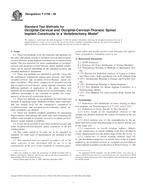Potřebujeme váš souhlas k využití jednotlivých dat, aby se vám mimo jiné mohly ukazovat informace týkající se vašich zájmů. Souhlas udělíte kliknutím na tlačítko „OK“.
ASTM F2706-08
Standard Test Methods for Occipital-Cervical and Occipital-Cervical-Thoracic Spinal Implant Constructs in a Vertebrectomy Model
Automaticky přeložený název:
Standardní zkušební metody pro týlní - krční a týlní - krční - hrudní páteře Implant konstruktů v Vertebrectomy modelu
NORMA vydána dne 1.8.2008
Informace o normě:
Označení normy: ASTM F2706-08
Poznámka: NEPLATNÁ
Datum vydání normy: 1.8.2008
Kód zboží: NS-54407
Počet stran: 14
Přibližná hmotnost: 42 g (0.09 liber)
Země: Americká technická norma
Kategorie: Technické normy ASTM
Anotace textu normy ASTM F2706-08 :
Keywords:
fatigue test methods, occipital-cervical spinal implant assembly, occipital-cervical spinal implant construct, occipital-cervical-thoracic spinal implant assembly, occipital-cervical-thoracic spinal implant construct, static test methods, vertebrectomy model, ICS Number Code 11.040.40 (Implants for surgery, prothetics and orthotics)
Doplňující informace
| Significance and Use | ||||||||||||||
|
Occipital-cervical and occipital-cervical-thoracic spinal implants are generally composed of several components which, when connected together, form either an occipital-cervical spinal implant assembly or an occipital-cervical-thoracic spinal implant assembly. Occipital-cervical and occipital-cervical-thoracic spinal implant assemblies are designed to provide some stability to the spine during the process of arthrodesis. These test methods outline standard materials and methods for the evaluation of different spinal implant assemblies to facilitate comparisons between different designs. These test methods are used to quantify the static and dynamic mechanical characteristics of different designs of occipital-cervical and occipital-cervical-thoracic spinal implant assemblies. The mechanical tests are conducted in vitro using simplified load schemes and do not attempt to mimic the complex loads of the occipital-cervical and occipital-cervical-thoracic spine. The loads applied to the spinal implant assemblies in vivo will, in general, differ from the loading configurations used in these test methods. The results obtained here cannot be used directly to predict in vivo performance. The results can be used to compare different component designs in terms of the relative mechanical parameters. Fatigue testing in a simulated body fluid or saline may cause fretting, corrosion, or lubricate the interconnections and thereby affect the relative performance of tested devices. This test should be initially performed dry (ambient room conditions) for consistency. The effect of the environment may be significant. Repeating all or part of these test methods in simulated body fluid, saline (9 g NaCl per 1000 mL water), a saline drip, water, or a lubricant should be considered. The maximum recommended frequency for this type of cyclic testing should be 5 Hz. The location of the longitudinal elements is determined by the intended in vivo location of the anchors. The perpendicular distance to the load direction between the axis of a hinge pin and the anchor's attachment points to a polyacetal block is independent of anchor-type for the cervical block, but dependent on the design for the occipital test block. The distance between the polyacetal block and the center of the longitudinal element is a function of the design of the implant. |
||||||||||||||
| 1. Scope | ||||||||||||||
|
1.1 These test methods cover the materials and methods for the static and fatigue testing of occipital-cervical and occipital-cervical-thoracic spinal implant assemblies in a vertebrectomy model. The test materials for most combinations of occipital-cervical and occipital-cervical-thoracic spinal implant components can be specific depending on the intended location and intended method of attachment. 1.2 These test methods are intended to provide a basis for the mechanical comparison among past, present, and future occipital-cervical and occipital-cervical-thoracic spinal implant assemblies. They allow comparison of occipital-cervical and occipital-cervical-thoracic spinal implant constructs with different methods of application to the spine. These test methods are not intended to define levels of performance, since sufficient knowledge is not available to predict the consequences of the use of a particular device. 1.3 These test methods set out guidelines for load types and methods of applying loads. Methods for three static load types and two fatigue tests for the comparative evaluation of occipital-cervical and occipital-cervical-thoracic spinal implant assemblies are defined. 1.4 These test methods establish guidelines for measuring displacements, determining the yield load, and evaluating the stiffness and strength of occipital-cervical or occipital-cervical-thoracic spinal implant assemblies. 1.5 It may not be possible to test some occipital-cervical and some occipital-cervical-thoracic spinal constructs in all test configurations. 1.6 The values stated in SI units are to be regarded as standard. No other units of measurement are included in this standard. 1.7 This standard does not purport to address all of the safety concerns, if any, associated with its use. It is the responsibility of the user of this standard to establish appropriate safety and health practices and determine the applicability of regulatory limitations prior to use. |
||||||||||||||
| 2. Referenced Documents | ||||||||||||||
|




 Cookies
Cookies
